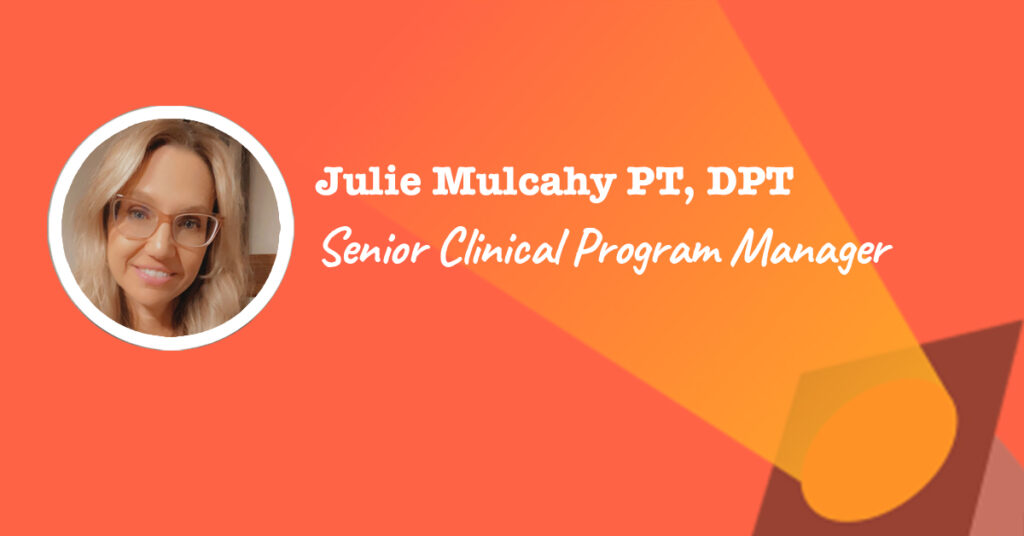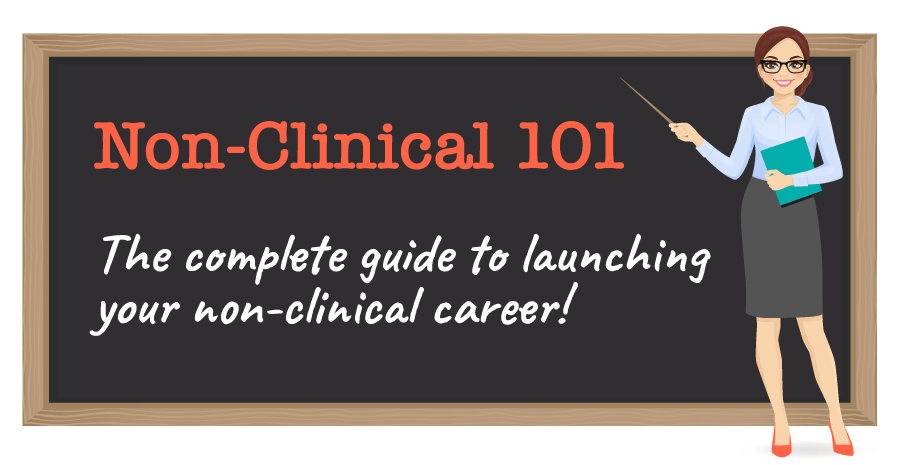This week, we’re featuring a physical therapist who now works as Senior Clinical Program Manager at Omada Health.
This post may contain affiliate links or codes. This won’t increase your cost, but it helps keep TNCPT alive, and free of annoying ads! Thank you for your support. 🙂
What is your full name and title at your current job?
Julie Mulcahy PT, DPT
Senior Clinical Program Manager at Omada Health

Where are you located?
Omada Health is located in San Francisco, California. However, I work remotely from Southeast Michigan.
Where did you go to PT school, and what year did you graduate?
I went to University of Michigan for my MPT and received my transitional doctorate in physical therapy (DPT) from University of Michigan in 2018.
What did you do when you first finished school, and for how long?
As a new PT graduate, I started my career in a large hospital system. I worked in acute care, home health and even a short while in a SNF.
However the majority of my 25 + year career as a PT has been in outpatient orthopedics, sports medicine and women’s health.
I designed and taught a prenatal exercise program and began treating antepartum women in the clinic.
What did you do after that, and for how long?
I left the hospital system for a private practice and was treating orthopedic and sports medicine patients. I became clinical coordinator at this facility and enjoyed working with students and mentoring PTs to be clinical instructors for student PTs.
I considered transitioning to an academic setting in a PT or PTA program. I began teaching in a PTA program as an adjunct faculty member.
I served on the editorial advisory board for https://www.choosept.com/ and authored and edited patient education guides and articles.
This is where my mindset began to change to think of ways I could leverage my experience and education as a PT and do something outside of strictly hands-on clinical patient care.
Editor’s note: Have an interest in writing, teaching, and education? Check out this spotlight on Erika del Pozo, MOT, OTR, who is now Patient Engagement Content Manager at MedBridge!
What did you enjoy about your early roles? What didn’t you enjoy?
I enjoyed patient care and the relationships I made with patients, families and colleagues over the years. I took extensive continued education to allow myself to practice using evidence-based treatment plans and growing in the PT profession. I enjoyed teaching students in the clinic and also in the classroom.
I did not enjoy having to meet unrealistic productivity expectations, increased documentation demands and clunky EMR’s.
I didn’t feel that my experience and expertise as a PT was valued in the clinical setting. I felt like I was a cog in a machine in a constant race for productivity with minimal time for professional development and limited ability for advancement in my career.
I was always fascinated by the use of technology in patient care and felt that it could be better leveraged in the clinical setting to help patients achieve better outcomes.
At what point did you realize you wanted to do something non-clinical with your background, and why?
I decided to pursue my transitional doctorate with the plan that I would transition to an academic setting.
My DPT coursework was online asynchronous learning with students all over the world. We relied heavily on technology in the program to stay connected as a class.
There were courses that incorporated technology into rehabilitation. I learned there were so many apps and other technology platforms that helped people with disabilities. This area was fascinating to me as I always wondered how PTs could leverage technology into patient care to improve patient engagement and outcomes.
In a discussion board post, I mentioned how PTs could reach so many more patients who do not have access to care (especially to PT specialists) by using virtual care. My classmates did not think it was a viable option for a hands-on profession.
This was in 2017, before the pandemic when virtual care became more utilized. At that moment, I knew that discovering virtual PT and incorporating technology into patient care was going to be the next step in my career.
This was a natural fit for me since I was the technology “go-to person” at my clinic helping other clinicians learn to use the EMR and online HEP platforms. I also am a huge lover of using apps! I used them for everything! It is ironic I now work for a virtual-first care company that provides PT care through an app!
What are you doing these days?
I started as a contract virtual PT with Physera in 2018, and I was promoted to clinical program manager at Physera in 2019.
Physera was a new tech startup for virtual PT. Physera was acquired by Omada Health in May 2020 to allow the addition of muskuloskeletal (MSK) care to their extensive product line.
I am currently a full-time senior clinical program manager for Omada Health. Omada Health is a leader in digital health technology and remotely manages care for prevention, hypertension, diabetes management, MSK issues and behavioral health.
In addition to carrying a small caseload of virtual treatments, I manage a nationwide network of PTs who treat patients virtually. There is also a technology side to my job, as I work with product designers, tech support, and software engineers. I also work with the Omada Health clinical staff, including coaches and specialists.
If you’re still treating patients, about what percentage of your time is spent clinically vs. non-clinically?
I continue to treat patients virtually for 25% of my time. It is important for me to continue to treat patients so I can make better recommendations to the product and engineering teams regarding the Omada MSK platform and to thoroughly understand the platform when onboarding new PTs.
The rest of my time is non-clinical. I help build educational content for the app, meet with the product and engineering teams for app development, and assist in bug discovery and reporting.
We are currently working on care coordination across product lines of Omada to ensure patients have all their needs addressed by each specialist to deliver high-quality and high-value healthcare.
For example, if a patient has MSK pain and diabetes, the patient care team consists of a physical therapist, a diabetes specialist and a health coach to collaborate to meet that patient’s goals to provide whole person care.
By combining proven clinical protocols and the science of behavior change, Omada reinvents the way we think about health to help build lasting change. This is a truly exciting part of working for Omada Health!
How long have you been in your current role?
I have been in my current role since August, 2019.
How did you find your job? Did you apply or find it through a connection?
When I completed my tDPT in 2018, I began to research companies that were doing virtual PT and there were not too many out there. I stumbled upon Physera, which was a new virtual PT startup.
I applied and got the job as a virtual PT. I started as a part time contractor and then was promoted to a full time management position.
Did you do anything special to your resume and cover letter to land the job?
I emphasized not only my orthopedic experience, but also management and technology skills. I emphasized anything technology related, such as being an EMR super user, learning various LMS platforms as a student and faculty member, projects, and research and articles that I had authored.
My time obtaining a completely remote tDPT program also helped increase my technology skill set. I continue learning every day, which makes my job so enjoyable!
What was the interview like for the role?
I did my research on the company and other competitors in the PT and MSK telehealth industry. Physera was looking for experienced orthopedic PTs who were comfortable with using technology and practicing in a direct access environment.

How did you move up from a treating telehealth clinician to your senior clinical program manager role?
My manager, who is the Director of Clinical Services of the Omada MSK program, has been a pioneer in virtual PT—and I have learned a lot from him. I moved up the ladder by being open to new opportunities and not being afraid to learn new things. I also made it a habit to do the following:
- Taking initiative on new opportunities
- Learning as much as I could about digital health startups
- Researching technology topics and lingo
Did you get any special certifications or training along the way to help you get into your current role?
I did not need any special certifications along the way.
However, I am in the process of obtaining my Certificate of Achievement in Obstetric Physical Therapy (CAPP OB) through the APTA. I have been treating prenatal and postpartum women through the Omada MSK platform virtually and I will be using this knowledge to assist our network of PTs in treating this patient population.
How have people reacted to you leaving patient care?
Many of my PT colleagues are intrigued by virtual care. I received many calls from PTs in the clinic looking to quickly pivot to virtual care once the covid-19 pandemic hit.
Many of my PT colleagues ask me how I can be so successful in getting patients better without hands on therapy…
Incidentally, the research for low back pain indicates the predictors of good outcomes are as follows:
- Exercise
- Behavior modification
- Education
I focus treatment on empowering my patients by teaching self care, providing education, and delivering exercise instruction. I truly get to do the fun part of PT in diagnosing, treating, and educating patients on how to self-manage their conditions.
How does the eval/treatment process work at Omada Health?
All of our MSK patients have an initial evaluation video visit and follow-up visits with a licensed PT. The patients receive a comprehensive, personalized care plan through our app and can communicate with the PT anytime in between video visits by texting in the app.
In that way, we meet members where they are and help members see and identify healthy behaviors and incorporate them in their lives to create lasting change.
Our PTs have access to a comprehensive, fully animated exercise library to enable them to create personalized care plans. We have access to extensive education articles and videos, as well as self-care activity reminders such as standing, walking, and using ice or heat, to name just a few.
A really exciting addition to our program is that we are utilizing computer vision technology to allow patients to assess their joint range of motion right through the app! A patient can visualize their progress as they move their joint through space and obtain an immediate objective measurement of range of motion.
When patients can visualize their progress we have learned that it leads to better engagement and outcomes!
Will you be at CSM, perchance? I know people will be dying to network with you and learn about Omada Health!
Yes! I’ll be at CSM 2022 in San Antonio, where my colleagues and I will be presenting “Telehealth Delivery of Physical Therapy: How a Hands-on Profession Can Provide Quality Care Remotely.”
I will also have a poster called “Telehealth Physical Therapy Management of Chronic Pain During Covid 19 Utilizing Pain Neuroscience Education.” It will be presented Friday, Feb 4 at CSM for the Orthopedic section.
What’s a typical day or week in the life like for you? What types of tasks and responsibilities fill your time?
A typical day would consist of:
- Delivering virtual patient care
- Onboarding new PTs
- Managing our nationwide network of PTs
- Meeting with product and engineering teams to constantly improve our platform
- Collaborating with Omada care teams to coordinate care across the different product lines of MSK, behavioral health, hypertension, diabetes and prevention
- Reporting bugs
- Developing content for the app
- Assisting in technical support and sales calls
- Serving as the clinical expert of our MSK product
What are some of the challenges of your role? What are the rewards?
In the beginning, working for a health technology company was a big transition from clinical work. My colleagues are not all clinicians. I learned a whole new language in communicating with software engineers, product, marketing and the commercial teams.
The rewards are being part of a revolution in healthcare with digital health technology and virtual care.
Being part of a company like Omada, which is using technology to help people manage chronic disease in collaboration with their physicians, is a new frontier in healthcare. I am fascinated and honored to be part of this journey.
I am able to remotely track activities and progress, and support patients in meeting their health goals in between live video visits with the PT. Using technology and data, we help keep patients engaged in their care plans, which we learned leads to better outcomes.
With the power of behavior science, combined with digital tools, it is possible to scale adoption of clinical protocols and help people make changes that last.
Another challenge in my role is to educate the public that there are digital health companies out there that address MSK conditions without using licensed PTs. These patients do not get an actual evaluation by a licensed PT, so it is important to educate the public on what constitutes treatment by a licensed medical provider vs. a health coach. It’s critical that patients know and understand the actual service they are receiving.
How do you think working as a PT prepared you for this role? Which skills transferred?
Most certainly my orthopedic experience, since I still have a partial clinical role. Other skills include:
- Communication
- Organizational skills
- Not being afraid to learn new things and ask questions
Health technology is a new field and constantly evolving. I am learning new things everyday.
Roughly speaking, how are the hours and salary pf a senior clinical program manager, compared to patient care?
Better pay and more flexibility in that I work remotely.
What type of person do you think would do well in your role?
- Comfortable with technology
- Able to develop new tech skills quickly
- Self starter
- Problem-solving skills
- Communication skills with multiple disciplines outside of the clinical realm.
Does your organization hire PT, OT, or SLP professionals into non-clinical roles? If so, what type of roles?
Yes we hire PTs! Check out our open positions here: https://www.omadahealth.com/careers
Did you read any books, take any courses, or do anything special overall to get you where you are today?
The books I have read most recently:
- Deep Medicine: How Artificial Intelligence Can Make Healthcare Human Again. By Eric Topol
- Measure What Matters: OKRs-The Simple Idea that Drives 10x Growth. by John Doerr
- Radical Candor by Kim Scott
What is a typical career path for someone in your role?
Being that digital health technology is a rapidly growing sector having a strong clinical background combined with technology skills would help in this type of role.
What is next for you? What do you want to do with your career long-term?
My role with Omada Health is constantly changing as virtual healthcare becomes more mainstream. The company is growing, and I look forward to helping build our network of PTs and scaling care coordination across product lines.
As PTs, we know how important it is to treat the patient as a whole person—and we are well-qualified as a profession to help those with chronic conditions learn to stay active and as healthy as possible.
Do you have any special words of wisdom for the readers?
Keep learning and applying for non-clinical roles that you are interested in. Take additional coursework pertinent to your area of interest.
Research the experience of those in roles you are interested in and make connections with PTs in those roles. I researched and applied for multiple non-clinical PT roles before I discovered my passion for digital health technology.
What would you like to change most in your profession, and why? How would you propose doing so?
I believe that PTs are well-educated and should be in a primary care role for management of MSK conditions. PT is the most cost effective treatment that works for MSK conditions, yet due to multiple barriers, patients are not getting care soon enough.
If you could give yourself one piece of career advice you wish you had during school, what would it be?
Back in PT school, I would have never predicted that I would be working for one of the leading companies in digital health.
Be flexible, and keep learning. Find PTs who are doing what you want and learn from them as to how they got there.
Curious how your own skills can translate into the non-clinical world? Feeling overwhelmed by all the options? Explore your options in an organized and strategic way with Non-Clinical 101: the comprehensive, fun, and inspiring course everyone is talking about!





